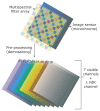Multispectral filter arrays: recent advances and practical implementation
- PMID: 25407904
- PMCID: PMC4279553
- DOI: 10.3390/s141121626
Multispectral filter arrays: recent advances and practical implementation
Abstract
Thanks to some technical progress in interferencefilter design based on different technologies, we can finally successfully implement the concept of multispectral filter array-based sensors. This article provides the relevant state-of-the-art for multispectral imaging systems and presents the characteristics of the elements of our multispectral sensor as a case study. The spectral characteristics are based on two different spatial arrangements that distribute eight different bandpass filters in the visible and near-infrared area of the spectrum. We demonstrate that the system is viable and evaluate its performance through sensor spectral simulation.
Figures

















References
-
- Stevenson A., editor. Oxford Dictionary of English. 2 ed. Oxford University Press; Oxford, UK: 2005.
-
- Launay F. The Astronomer Jules Janssen: A Globetrotter of Celestial Physics. Springer; New York, NY, USA: 2011.
-
- Goetz A.F. Three decades of hyperspectral remote sensing of the Earth: A personal view. Remote Sens. Environ. 2009;113:S5–S16.
-
- Lapray P.-J., Thomas J.-B., Gouton P. A Multispectral Acquisition System Using MSFAs. Proceedings of Color and Imaging Conference; Boston, MA, USA. 3–7 November 2014; submitted for publication.
-
- Morris H.R., Hoyt C.C., Treado P.J. Imaging Spectrometers for Fluorescence and Raman Microscopy: Acousto-Optic and Liquid Crystal Tunable Filters. Appl. Spectrosc. 1994;48:857–866.
LinkOut - more resources
Full Text Sources
Other Literature Sources

